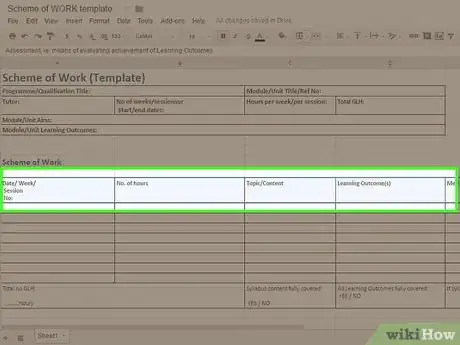This article was co-authored by wikiHow Staff. Our trained team of editors and researchers validate articles for accuracy and comprehensiveness. wikiHow's Content Management Team carefully monitors the work from our editorial staff to ensure that each article is backed by trusted research and meets our high quality standards.
This article has been viewed 443,636 times.
Learn more...
A scheme of work is a plan for instructors to outline what they will teach during an academic term or period. To write one, check to see if your institution has a template or specific requirements. Otherwise, look online or draft your own. Review course materials, set up academic objectives, and collaborate with students to plan a schedule that will suit them best. Break down the overall learning experience into unit plans, and plan around conflicts.
Steps
Choosing the Format
-
1Check if your workplace has a standard template. Check with the administration at your institution to see if there is a specific template to be used for a scheme of work. Ideally, look at a scheme of work left by your predecessor. If one isn't available, ask a few colleagues if you can see their schemes of work and look for predominant commonalities between them to gauge what is expected at the institution.[1]
-
2Look online. Schemes of work are available on teaching resource websites for purchase and download. Search for one to save yourself time in the lesson planning process, or to have a template to modify. Be sure that any school or department-specific requirements are acknowledged and listed on the document you end up with.[2]
- For instance, schemes of work are available on Click Teaching, a teaching resource website that teachers can subscribe to for approximately $50 a year.
Advertisement -
3Create a scheme of work from scratch. Use a Word document (and make a table on it) or create an Excel spreadsheet to write your schedule of work. Start by adding the basic information and add to the document as you wish (e.g. adding a column called “Initials” or “Signature” at the end of the chart to sign and show that a learning goal was completed on schedule . Create several main columns in the chart, labelled:
- “Date” or “Lesson number”, to delineate each interval
- “Topic” (i.e. the overall subject matter of a specific unit)
- “Lesson content”: a brief overview of the lesson planned, which can be broken down into sub-topics
- “Specific objectives”
- “Learning Activities”
- “Resources”
- “Assessment”
- “Remarks”
Reviewing Course Content
-
1Read through the course materials. To get a better idea of how the course content will unfurl over the course of the term, read through the main course materials as outlined in last year’s syllabus or scheme of work. If there is a specific textbook associated with the subject that you’re teaching (e.g. mathematics), review it and take note of how much focus is allotted for different topics. Complete your scheme of work accordingly.
- For instance, two chapters might be devoted to polynomial functions, while differential equations might only be covered in one chapter.
-
2Divide reading time appropriately. If multiple course materials are assigned for a course, decide how much time and academic focus each should be allotted. For example, if various novels or plays are assigned in an English course, give each a sufficient measure of focus. If you add or remove course content, make sure that there is an appropriate amount of reading for each week.
-
3Research your constraints. Before planning and detailing your scheme of work, get information about the curriculum requirements in place at your institution. For instance, students might have to master a certain set of skills in an introductory course to be prepared for a more advanced course the following year. Ask the school administration, or review the previous instructor’s work and materials to get a better idea of what constraints might be in place.
- In addition, look into whether the class could benefit from new course materials and updated unit plans of learning.
-
4Set out academic objectives. Based on the course materials and grade requirements, write a list of learning objectives for each individual unit and for the course as a whole. Adjust and edit these objectives as you work out time constraints and actionable learning activities, to ensure that you add well-thought out goals to your scheme of work. Make sure that each objective follows the S.M.A.R.T. acronym:[3]
- Specific
- Measurable
- Attainable/achievable
- Realistic
- Time-bound
-
5Collaborate with students. Schemes of work are working documents, so you can always collaborate with students or colleagues and adjust the document after the initial copy is produced. This offers the opportunity for you to confer with students about upcoming learning activities and goals, and modify them accordingly. Show students a copy of the first draft of your scheme of work and get their feedback and ideas about how learning should progress.[4]
- For instance, a teacher may have initially scheduled a brief lecture and note-taking for a lesson on the Cold War, but amends the unit plan to schedule a class discussion instead to defer to the preferences of the class.
Estimating Time Requirements
-
1Break down the duration of the course. Break down the total duration of the class into the key topics to be covered, or units. Each one of these sections should account for a fundamental lesson to be learned at a specific interval of the term in order to fulfill the curriculum requirements. These unit plans should cover either a week or a month of study and together, form an organized sequence of learning for students.[5]
- For instance, in an introductory Anthropology course, you might plan a week-long unit entitled “The Agricultural Revolution” during which you will teach students about the origins and rise of farming.
-
2Factor in scheduling interruptions. When planning the schedule, make a point of noting all upcoming events and conflicts that will interrupt a straight-forward, linear scheme of work. Look through a calendar to mark down statutory holidays, and through a school calendar to take note of any school breaks, examinations, or assemblies that will interrupt normal class time. Allow time for review and practice in the event that students have trouble grasping course material and need more time to absorb it.
- For example, a unit like WWII in a 20th century history course might be stretched over two weeks instead of one week to accommodate a statutory holiday, and allow for review to ensure that all students are well-versed in this important component of the class.
-
3Work around other teachers' schedules. Consult with colleagues to ensure that there are no major conflicts with your schedules. For example, avoid scheduling a major assignment on a day that your students will have a midterm exam in another class. Advise teachers of your prospective dates for exams and major projects.
Community Q&A
-
QuestionWhat are the objectives of scheme of work?
 Community AnswerTo ensure that the entire syllabus for the year is taught, and in the correct time frame.
Community AnswerTo ensure that the entire syllabus for the year is taught, and in the correct time frame. -
QuestionWhat is the aim of a scheme of work?
 Community AnswerA plan for instructors to outline what they will teach during an academic term or period.
Community AnswerA plan for instructors to outline what they will teach during an academic term or period. -
QuestionWhen and how would I prepare a scheme of work?
 Community AnswerThe scheme of work should be ready by the beginning of the academic year. Some of the key issues included are user name or class, period covered, number of weeks, number of lessons, objectives of the lesson/whether they have been achieved, teaching aids needed and syllabus topics.
Community AnswerThe scheme of work should be ready by the beginning of the academic year. Some of the key issues included are user name or class, period covered, number of weeks, number of lessons, objectives of the lesson/whether they have been achieved, teaching aids needed and syllabus topics.
References
- ↑ https://www.oneeducation.org.uk/wp-content/uploads/2019/07/7.-U9002-Information-leaflet-Creating-a-Scheme-of-Work-1.pdf
- ↑ https://www.educationandemployers.org/wp-content/uploads/2014/11/Subject-schemes-of-work-in-one-document-05.11.14.pdf
- ↑ https://www.indeed.com/career-advice/career-development/smart-goals
- ↑ https://www.educationandemployers.org/wp-content/uploads/2014/11/Subject-schemes-of-work-in-one-document-05.11.14.pdf
- ↑ http://files.eric.ed.gov/fulltext/EJ1082472.pdf
About This Article
To write a scheme of work, start by making a table on a blank document or spreadsheet. Then, label the columns in the table so each one corresponds with a different section of your scheme of work. You should include a "Date" or "Lesson number" column to specify each interval, as well as "Topic," "Lesson Content," "Special Objectives," "Learning Activities," and "Resources" columns. You'll also want an "Assessment" and "Remarks" column that you can fill in later on. For tips on reviewing your course content and estimating the time requirements, keep reading!




































































